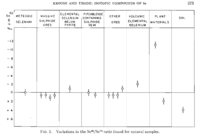Difference between revisions of "PAA Selenium"
| (4 intermediate revisions by the same user not shown) | |||
| Line 8: | Line 8: | ||
=Can one use plant material to measure the provenance of selenium?= | =Can one use plant material to measure the provenance of selenium?= | ||
| + | |||
| + | [[Se_Overview_PrevMeas]] | ||
As shown in the Figure below, the Se-82/Se-76 ratio varies from -1.2% to +0.2% for plant materials but remains relatively constant for other materials. The variations in plant material has been described as being due to differences in the bacteria residing in the plant. The question to investigate is whether or not these variations in the concentration can be used to determine the provenance of the sample. | As shown in the Figure below, the Se-82/Se-76 ratio varies from -1.2% to +0.2% for plant materials but remains relatively constant for other materials. The variations in plant material has been described as being due to differences in the bacteria residing in the plant. The question to investigate is whether or not these variations in the concentration can be used to determine the provenance of the sample. | ||
| Line 67: | Line 69: | ||
=Experiments= | =Experiments= | ||
| + | |||
| + | ==[[PAA_Selenium_ActivityCalc]]== | ||
| + | |||
[[PAA Selenium/Soil Experiments]] | [[PAA Selenium/Soil Experiments]] | ||
Latest revision as of 22:10, 17 May 2019
Using PAA ro measure Selenium concentrations.
According to Krouse<ref name="Krous1962"> H.R. Krause and H.G. Thode,"Thermodynamic Properties and Geochemistry of Iosotopic Compounds of Selenium",.Can. J. Chem., vol 40, pg 367</ref> , the fractional concentration of Se-82/Se-76 in plant material is observed to be less than from primordial (meteoric) concentrations by as much as 1.2%. Anaerobic bacteria are known to reduce selenates and senelites in biological systems. This may be the reason plant material has fractionation of selenium isotopes. They also observe excess concentrations of up to 0.4% in soil.
Plant material appears to detect environmental selenium.
Can one use plant material to measure the provenance of selenium?
As shown in the Figure below, the Se-82/Se-76 ratio varies from -1.2% to +0.2% for plant materials but remains relatively constant for other materials. The variations in plant material has been described as being due to differences in the bacteria residing in the plant. The question to investigate is whether or not these variations in the concentration can be used to determine the provenance of the sample.
Below is a table listing the natural abundances of Selenium
Natural abundance of selenium
| Isotope | Abundance |
| Se-74 | 0.86% |
| Se-76 | 9.23% |
| Se-77 | 7.60% |
| Se-78 | 23.69% |
| Se-80 | 49.80% |
| Se-82 | 8.82% |
Below are possible PAA reactions that may be used to observe specific Se isotopes
| Reaction | Half-life | Relative activity | Gamma-rays, keV (BR) |
| Se-74(gamma,n)Se-73 | 7.1 h | 1.5E-1 | 361 (100) |
| Se-74(gamma,n)Se-73m | 39 m | 3.2 | 402 (4) |
| Se-74(gamma,np)As-72 | 26 h | 1.0E-3 | 834 (100) |
| Se-76(gamma,n)Se-75 | 120 d | 1.3E-2 | 265(29) |
| Se-77(gamma,p)As-76 | 26.4 h | 4.4E-2 | 559(44) |
| Se-78(gamma,p)As-77 | 38.8 h | 8.6E-2 | 239(2) |
| Se-80(gamma,n)Se-79m | 3.9 m | 5.9 | 96(10) |
| Se-80(gamma,np)As-78 | 1.5 h | 2.2E-2 | 614(54) |
| Se-80(gamma,p)As-79 | 8.2 m | 1.3 | 96(9) |
| Se-80(gamma,p)Ge-75 | 83 m | 2.8E-1 | 265(11) |
Can one perform PAA measurements of Se-82 and Se-76?
Experiments
PAA_Selenium_ActivityCalc
LB Se PAA Horse Feed Experiment
Background Signals
Nickel Normalization
First Observation of Se lines
Using the 44 Machine at 7 kW power and 44 meV incident electron energy to produce a bremsstrahlung spectrum with a mean energy of 15 meV.
All runs lasting less than 214 seconds have time stamp that gives real time if you divide by clock frequency of 20 MHz. The first 32 bits are used for a real time measurement.
MDA and Se mass Calculations
IAC Detector Efficiencies
LB PAA IAC Detector Efficiencies
IAC Detector Calibrations
LB April DetB DetA Calibration
Runlists
LB PAA Runlist 4/01/16 - 06/02/16
Data Analysis
References
<references/>
File:Krouse CanJournChem 40 1962 p367.pdf
Goryachev, A. M., & Zalesnyy, G. N. (n.d.). The studying of the photoneutron reactions cross sections in the region of the giant dipole resonance in zinc, germanium, selenium, and strontium isotopes. Retrieved September 16, 2016, from http://www-nds.indcentre.org.in/exfor/servlet/X4sSearch5?EntryID=220070
Goryachev, B. I., Ishkhanov, B. S., Kapitonov, I. M., Piskarev, I. M., Piskarev, V. G., & Piskarev, O. P. (n.d.). Giant Dipole Resonance on Ni Isotopes. Retrieved October 26, 2016, from http://www-nds.indcentre.org.in/exfor/servlet/X4sGetSubent?reqx=119235&subID=220597006&plus=1
Handbook on Photonuclear data for applications, cross sections, and spectra. (2000, October). Retrieved November 4, 2016, from http://www-pub.iaea.org/MTCD/Publications/PDF/te_1178_prn.pdf
MSDS
Selenium shot, amorphous, 2-6 mm, Puratronic, 99.999% Alfa Aesar product # 10603 File:AlphaAesarSelenium MDSD.pdf
Informative links
https://inldigitallibrary.inl.gov/sti/3169894.pdf
